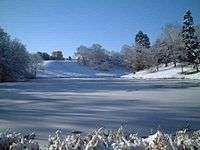Newton Park
Newton Park is an 18th-century grade I listed[1] country house in the parish of Newton St Loe, Somerset, England, situated 4 miles (6.4 km) west of Bath.


History
Newton Park was built in 1762–5 by Joseph Langton (grandson of Joseph Langton (c.1637–1719), of Newton Park, Member of Parliament for Bath from 1690 to 1695,[2]) to the design of Stiff Leadbetter.[3] Newton Park was the ancestral home of the women's rights campaigner Lady Anna and M.P. William Henry Powell Gore-Langton (1824 1873).[4]
The house was used as a Red Cross hospital to house Australian and New Zealand troops in World War I.[5] Newton Park is currently home to the administrative staff of Bath Spa University
Grounds and park

The estate includes a landscaped park, near the village of Newton St Loe, designed by Capability Brown, and now owned by the Duchy of Cornwall. It was laid out on land containing the 14th century keep and gateway of St Loe's Castle, a fortified medieval manor house, Elizabethan farm buildings, and various enclosed gardens.[6] The park is today bounded on one side by the A39 Wells Road and reaches right up to the residential roads of the village of Newton St Loe to its east. Some of the park is leased to Bath Spa University, which maintains the historic Georgian manor house and ornamental lakes, as well as Newton Saint Loe Castle. The park is grade II* listed.[7] Corston Brook flows through the west of the park and can be described as terraced, with numerous weirs, which have allowed for the creation of two large fish ponds, naturally shaped, by the main buildings. 500 metres north of the park the brook feeds into the Avon.
The north-east point of the park narrowly excludes The Globe, a public house on the roundabout junction of the A4 road, which is grade II listed[8] and a point on the edge of minor woods around the northern grounds marks the start of the A39 road which extends from the grounds (just north of a listed pair of gatepiers, railings, outpiers and flanking quadrant walls to the park) SSW then W to Falmouth, Cornwall.
References
- Historic England. "Newton Park (1312838)". National Heritage List for England. Retrieved 19 November 2006.
- http://historyofparliamentonline.org/volume/1690-1715/member/langton-joseph-1637-1719
- Colvin, Howard, A Biographical Dictionary of British Architects, 1600–1840 3rd ed. 1995, s.v. "Leadbetter, Stiff".
- Elizabeth Crawford, ‘Langton, Lady Anna Eliza Mary Gore- (1820–1879)’, Oxford Dictionary of National Biography, Oxford University Press, 2004 accessed 7 Nov 2017
- "History". Clifton RFC. Retrieved 6 August 2008.
- "Newton Park, Bath, England". Parks & Gardens UK. Parks and Gardens Data Services Limited (PGDS). Retrieved 9 June 2013.
- Newton Park (Park and Garden) Grade II* listing Historic England. "Details from listed building database (1000567)". National Heritage List for England. Retrieved 7 September 2013.
- Historic England. "Details from listed building database (1365666)". National Heritage List for England. Retrieved 7 September 2013.